

What is the Size of a PowerPoint Slide in Pixels?
By: Author Shrot Katewa

When creating a PowerPoint presentation, it is essential to determine the appropriate size for your slides. Understanding the size of a PowerPoint slide in pixels is crucial to ensure that your presentation looks great on all devices, from desktops to mobile devices.
The standard size of a PowerPoint slide is 1024×768 pixels and the widescreen PowerPoint slide is “1920×1080” pixels. It can also be adjusted based on your preferences or the requirements of the platform on which you plan to present your slides.
In this article, we will discuss the standard size of a PowerPoint slide in pixels or inches as well as how to adjust it to fit your needs. Let’s get started!
1. What is the Size of a PowerPoint Slide in Pixels?
In Microsoft PowerPoint, there are multiple preset slide sizes available. You can also customize the size of the slide using the “Custom Slide Size” feature available in the application. Depending on the slide size you select, the size of the slide in pixels will vary.
1.1 What is the Size of a PowerPoint Standard Slide in Pixels?

The “Standard (4:3)” option in Microsoft PowerPoint used to be the only size option in the beginning since most screens from 2010 and before were that size. The standard slide size in PowerPoint is “1024×768” pixels.
1.2 What is the Size of a PowerPoint Widescreen Slide in Pixels?

In Microsoft PowerPoint, the default size of the slides is the “Widescreen (16:9)” option. The widescreen PowerPoint slide is “1920×1080” pixels.
2. What is the Size of a PowerPoint On-Screen Show Slide in Inches?
In Microsoft PowerPoint, the size of the slides is mostly measured in inches. Using the “Slide Size” dialog box, you can check the dimension of a slide in inches. Depending on the type of the selected slide, the slide size varies. There are three different “On-Screen Show” slide sizes available in Microsoft PowerPoint.
2a On-Screen Show (4:3)

The “On-Screen Show (4:3)” slides are “10×7.5” inches in size. This is the “Standard” slide size.
2b On-Screen Show (16:9)
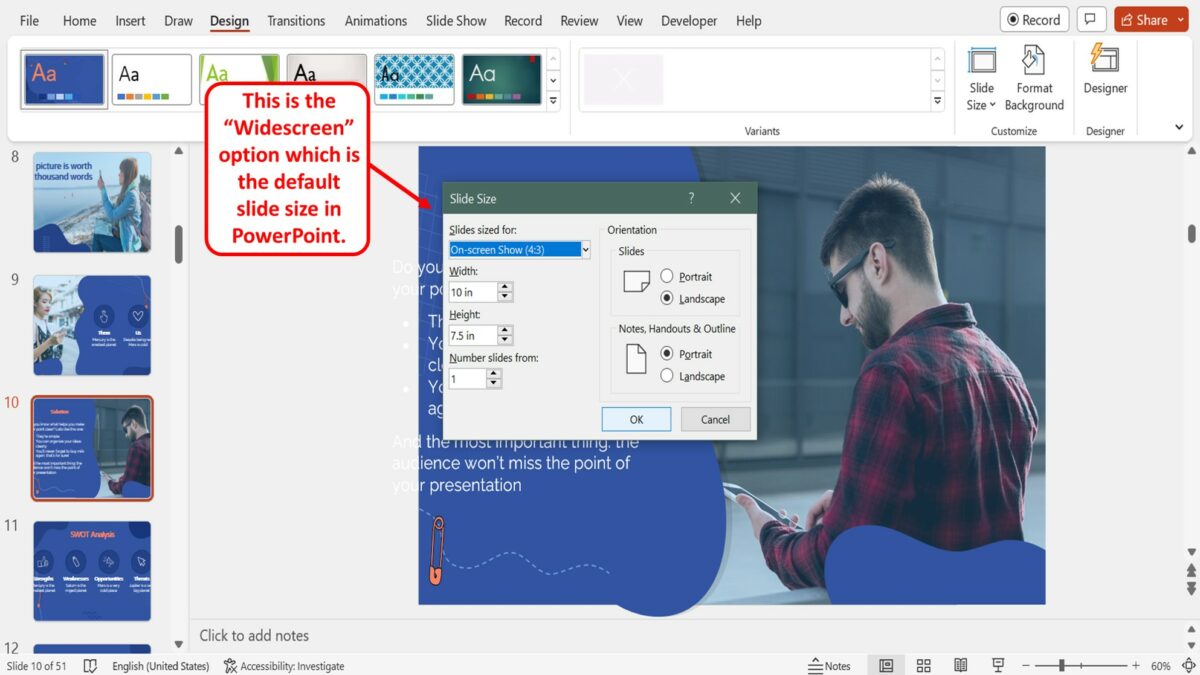
The “On-Screen Show (16:9)” slide size is “10 x 5.625” inches in dimension. This is the “Widescreen” option which is the default slide size in PowerPoint.
2c On-Screen Show (16:10)

The “On-Screen Show (16:10)” slides are “10 x 6.25” inches in width and height respectively.
3. How to Find the Size of the Slide in Inches?
Using the “Slide Size” dialog box in Microsoft PowerPoint, you can find the size of the slides in your presentation in inches. To do so, follow the 3 quick steps.
Step-1: Click on the “Design” tab
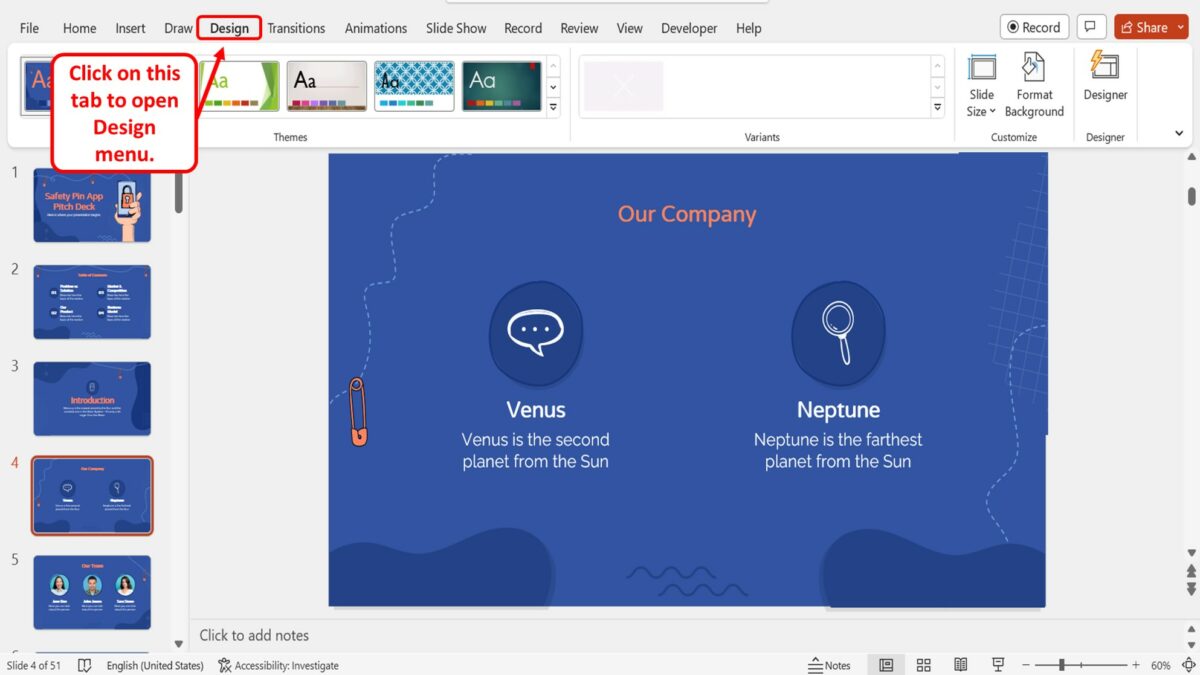
In the menu ribbon located at the top of the screen, click on the “Design” tab. This will open the “Design” menu.
Step-2: Click on the “Slide Size” option

In the “Customize” group of the “Design” menu, click on the “Slide Size” option. Then click on the “Custom Slide Size” option in the dropdown menu under the “Slide Size” option. This will open a dialog box.
Step-3: Click on the “OK” button

In the “Slide Size” dialog box, you can now see the size of the slide in inches in the “Width” and “Height” boxes. Then click on the “OK” button at the bottom of the dialog box to close it.
4. How to Change the Size of a PowerPoint Slide?
In Microsoft PowerPoint, you can change the side of the slides using the “Design” menu. However, you can only change the size of all the slides in a presentation at once. To change the size of the slide in PowerPoint, follow the 3 simple steps.

The first step is to open the “Design” menu. To do so, click on the “Design” tab in the menu ribbon located at the top of the screen.

In the “Customize” group of the “Design” menu, you have to now click on the “Slide Size” option. This will open a dropdown menu containing the preset slide size options available in PowerPoint.
Step-3: Click on your preferred slide size

Finally, all you have to do is click on your preferred slide size option from the preset options available in the dropdown menu under the “Slide Size” option. The available slide sizes are “Standard” and “Widescreen” .
4.1 How to Customize the Size of a PowerPoint Slide?
The “Custom Slide Size” feature in Microsoft PowerPoint allows you to customize the size of all the slides in a presentation. Using the feature, you can set any dimension to the slides in your presentation. To customize the size of the slides in a presentation, follow the 7 easy steps.

The first step is to open the PowerPoint presentation file where you want to customize the size of the presentation slides. Then click on the “Design” tab in the menu ribbon located at the top of the screen to open the “Design” menu.
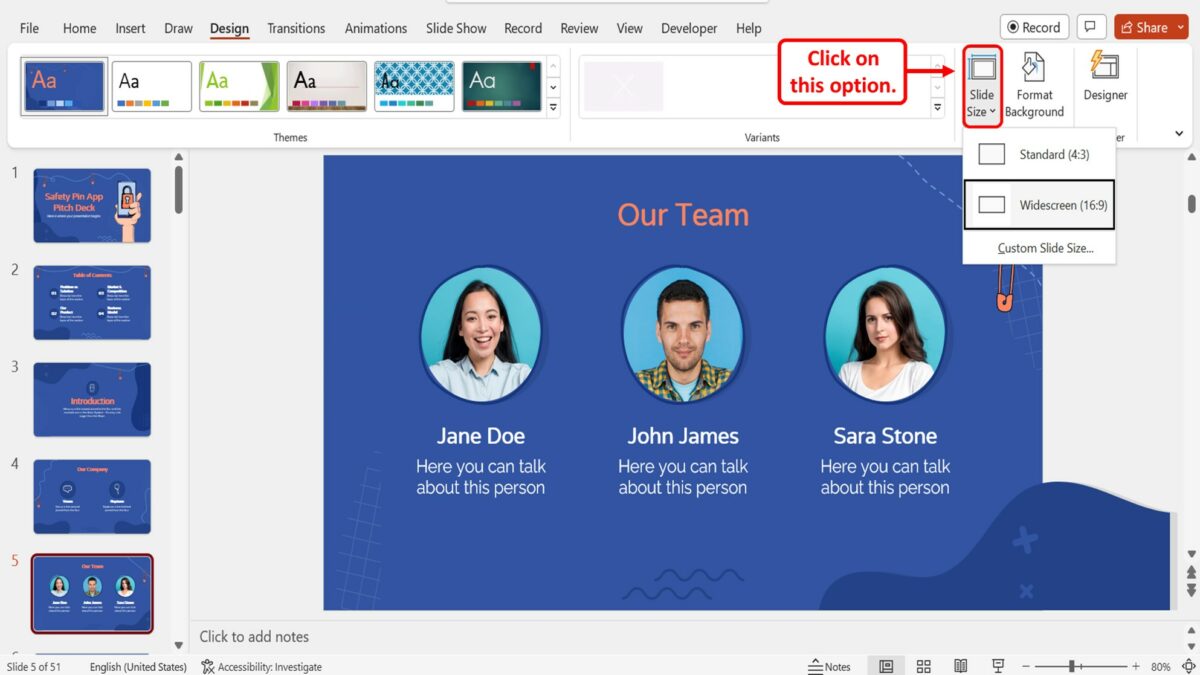
The next step is to click on the “Slide Size” option in the “Customize” group of the “Design” menu. In the dropdown menu, the default slide size is the “Widescreen (16:9)” option.
Step-3: Click on the “Custom Slide Size” option

Now all you have to do is click on the “Custom Slide Size” option at the bottom of the dropdown menu under the “Slide Size” option in the “Design” menu. This will open a dialog box.
Step-4: Click on the “Slide sized for” option

In the “Slide Size” dialog box, click on the “Slides sized for” option. Then click on the “Custom” option at the bottom of the dropdown menu under the “Slides sized for” box.
Step-5: Click on the “Width” box

In the “Slide Size” dialog box, the next step is to click on the “Width” box. Now you can type in your preferred width of the slides in inches. You can also use the up and down arrows in the “Width” box to increase or decrease the width of the slide respectively.
Step-6: Click on the “Height” box

The next step is to customize the height of the slides. To do so, click on the “Height” box in the “Slide Size” dialog box and type in your preferred slide height in inches. You can also click on the up or down arrows in the “Height” box to adjust the height of the slides to your preference.
Step-7: Click on the “OK” button
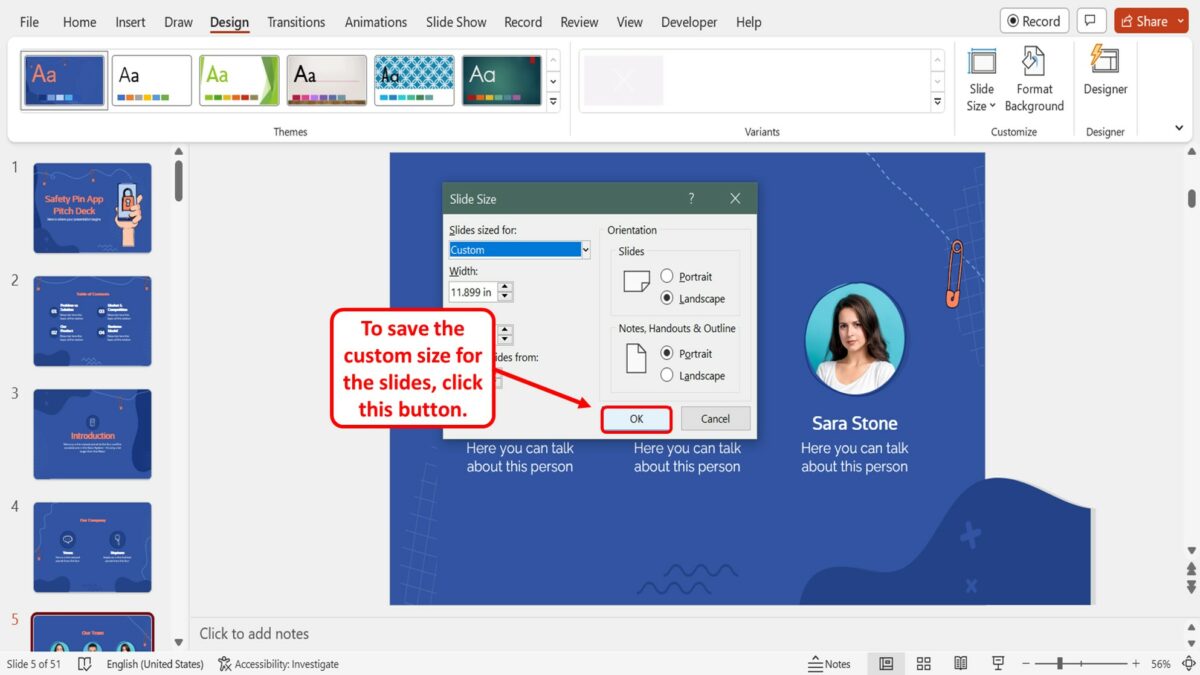
Finally, all you have to do is click on the “OK” button at the bottom of the “Slide Size” dialog box to save the custom size for the slides in the presentation file.

How to Change Slide Size or Dimensions in PowerPoint
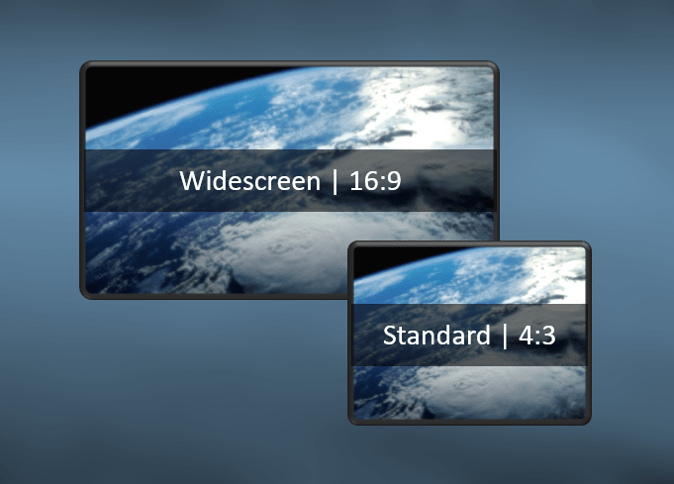
Change PowerPoint Slide Size (Widescreen, Standard or Custom)
by Avantix Learning Team | Updated October 25, 2024
Applies to: Microsoft ® PowerPoint ® 2016, 2019, 2021 and 365 (Windows)
You can change the slide size or aspect ratio of a PowerPoint presentation in all versions. The default slide size or dimensions is widescreen (16:9 aspect ratio). You can also enter a custom slide size if you prefer (including entering slide size in pixels). The best time to set slide size is when you first set up your PowerPoint presentation before you add any content. If you change the size later in the process, you may have to deal with distorted pictures and you may also need to adjust the position and size of various objects on slides in Normal View and in the slide master(s) and layouts in Slide Master View.
In this article, we'll review:
When to use widescreen or standard sizes
Change slide size to widescreen or standard, change slide size to a custom size, issues when changing slide size, dimension differences between different slide sizes, tips when changing slide size.
You should never change slide size just before running a presentation as you may not be satisfied with the results. If you already have a presentation with images and other content, it's also a good idea to change slide size on a copy of the presentation so you can keep the original deck and slide size.
Note: Some Ribbon tabs may appear with slightly different names if you are working with PowerPoint 365 and have a smaller screen or different display settings. Buttons on the Ribbon may appear as icons only and are also affected by screen size and display settings.
Recommended article: How to Reduce the Size of PowerPoint Presentations (10 Ways to Compress Your PowerPoint Decks)
Do you want to learn more about PowerPoint? Check out our virtual classroom or live classroom PowerPoint courses >
The most common slide sizes or aspect ratios are typically used as follows:
- Widescreen or 16:9 aspect ratio is frequently used for onscreen presentations using a projector, monitor or a widescreen TV. Older projectors used the standard aspect ratio but most new projectors are designed for widescreen.
- Standard or 4:3 aspect ratio is often used if slides are intended to be printed on letter size paper.
Slide size changes affect the entire presentation. You cannot change slide size for single slides.
To change slide size to widescreen or standard size:
- In Normal View, click the Design tab in the Ribbon.
- Click Slide Size in the Customize group. A drop-down menu appears.
- Select Widescreen, Standard or another option from the drop-down menu. A dialog box appears with options to maximize content or scale to fit (this dialog appears only if you are moving from a larger to a smaller slide size).
- Select the desired option.
Slide Size appears on the Design tab in the Ribbon:

The following dialog box appears in PowerPoint to maximize content or scale to fit only when you change slide size to a smaller size (such as widescreen to standard):

If you select Maximize, the slide content will not be resized when you change to the smaller slide size.
If you select Ensure Fit, PowerPoint will scale your content to fit the smaller slide size.
You can use custom slide sizes. Simply choose options from the Slides sized for drop-down menu in the dialog box (such as A4 paper size) or enter custom dimensions.
To change slide size to a custom size:
- Choose Custom Slide Size from the drop-down menu. A dialog box appears.
- Select an option from the Slides sized for drop-down menu or enter the desired slide size in the Height and Width boxes.
- A dialog box appears with options to maximize content or scale to fit (this dialog appears only if you are moving from a larger to a smaller slide size).
Note that the measurement system in PowerPoint dialog boxes is based on your system settings. If you would like to change the measurement system, check out our article on How to Change the Measurement System in PowerPoint.
The following dialog box appears when you select Slide Size and then Custom Slide Size:

You can create posters in PowerPoint by entering a custom slide size such as 36 inches wide by 56 inches high or 91.44 cm wide by 142.24 cm high. The maximum slide size in PowerPoint is 56 inches or 142.24 cm. As a best practice, set the slide size before adding content to the poster.
Many PowerPoint users are not aware that you can enter slide size in pixels (simply enter the measurement with px beside the number). This is useful in a number of situations such as using PowerPoint to create social media posts. If you enter slide size in pixels (such as 200px), when you tab to another box or close the dialog box, PowerPoint changes the pixels to the equivalent in the current measurement system.
When changing slide size in existing presentations with content, 4 common issues occur:
- Pictures may be distorted as PowerPoint tries to adjust images to fit slide size. Images on slides in Normal View will be affected as well as images on the slide master(s) and layouts. If pictures are distorted, you will need to either manually resize each image or delete them and insert them again.
- Objects such as placeholders and shapes that have been created in PowerPoint are not in the position you'd like. You may need to move objects or reset one or more slides (on the Home tab in the Ribbon, click Reset in the Slides group).
- Extra space is created if you change to a larger slide size. You may need to move or resize objects and adjust the slide master(s) or layouts in Slide Master View.
- If you have changed to a smaller slide size, you may need to increase font size for placeholders and text boxes.
In PowerPoint 2013 and later versions, widescreen (16:9) format measurements are different and are set to 13.33 inches wide by 7.5 inches high or 33.867 cm wide by 19.05 cm high. This matches the height of the 4:3 format.
To avoid issues in PowerPoint related to slide size, you should:
- Try to set slide size as a first step after you create a presentation and before you have entered any content. In 2013 and later versions, the default is widescreen (16:9 aspect ratio).
- If you have changed slide size in a presentation with content, review your slides to be sure you are satisfied with the results. You should also check the slide master(s) and layouts in Slide Master View.
- Never change slide size just before running a presentation as you may not be pleased with the results and you won't have time to fix your slide deck.
- If you have created a presentation with content, make a copy of the presentation first and change slide size on the copy.
Final Thoughts
Keep in mind that widescreen is normally used for on screen presentations and standard is often used for printed presentations.
This article was first published on October 6, 2019 and has been updated for clarity and content.
Subscribe to get more articles like this one
Did you find this article helpful? If you would like to receive new articles, JOIN our email list.
More resources
How to Blur Text on a PowerPoint Slide
How to Get Slide Design Ideas Using PowerPoint Designer
How to Change Picture Brightness or Contrast in PowerPoint
How to Insert Slide Numbers in PowerPoint Presentations (Step-by-Step)
Where to Find Free Images for Your PowerPoint Presentations (10 Great Stock Photo Sites)

Related courses
Microsoft PowerPoint: Intermediate / Advanced
Microsoft PowerPoint: Design for Non-Designers
Microsoft PowerPoint: Animations Bootcamp
Microsoft Excel: Intermediate / Advanced
VIEW MORE COURSES >
Our instructor-led courses are delivered in virtual classroom format or at our downtown Toronto location at 18 King Street East, Suite 1400, Toronto, Ontario, Canada (some in-person classroom courses may also be delivered at an alternate downtown Toronto location). Contact us at [email protected] if you'd like to arrange custom instructor-led virtual classroom or onsite training on a date that's convenient for you.
Copyright 2024 Avantix ® Learning
You may also like

10 Keyboard Shortcuts in PowerPoint's Outline View
The outline has been an integral part of Microsoft PowerPoint for many years. It is dynamically linked to slide placeholders and is organized in a hierarchical way.

How to Change the Thumbnail for a Video in PowerPoint (using the Poster Frame Tool)
If you have inserted a video on a PowerPoint slide, you can display a custom thumbnail (or Poster Frame) for the video during a slide show. The thumbnail will display when you run a PowerPoint slide show and disappears when you start the video. For most videos, the thumbnail that displays is the first frame of the video clip. You can use the Poster Frame command to display a different frame in the video clip or a picture from another source as a thumbnail. A picture thumbnail could be either an image or an icon.

How to Use the Built-in Laser Pointer in PowerPoint (with Shortcuts)
During a PowerPoint slide show, you can change your mouse into a laser pointer to focus attention on a specific area on your slide. You can show or hide the built-in laser pointer using keyboard shortcuts or by using the context menu.
Microsoft, the Microsoft logo, Microsoft Office and related Microsoft applications and logos are registered trademarks of Microsoft Corporation in Canada, US and other countries. All other trademarks are the property of the registered owners.
Avantix Learning |18 King Street East, Suite 1400, Toronto, Ontario, Canada M5C 1C4 | Contact us at [email protected]

Our Courses
Avantix Learning courses are offered online in virtual classroom format or as in-person classroom training. Our hands-on, instructor-led courses are available both as public scheduled courses or on demand as a custom training solution.
All Avantix Learning courses include a comprehensive course manual including tips, tricks and shortcuts as well as sample and exercise files.
VIEW COURSES >
Contact us at [email protected] for more information about any of our courses or to arrange custom training.
Privacy Overview
Pin it on pinterest.
- Print Friendly
How to change the size of slides in Microsoft PowerPoint
The actual size(s) of the slide is less important than the aspect ratio. By default, slides in presentations that you create from the Blank Presentation template are set to Widescreen size.
To change the size of your presentation slides, on the Design tab, in the Customize group, click the Slide Size button and then:
Notes : The Standard slide size:
- 1600 x 1200
- 2048 x 1536
- 2560 x 1920
- Matches the aspect ratio of standard tablet screens
- Exactly fills the screen in the Slide pane and when printed on a tablet.
Notes : The Widescreen slide size:
- 1920 x 1080
- 2048 x 1152
- 2560 x 1440
- Does not match the aspect ratio of standard tablet screens
- Has empty space above and below when printed on a 4:3 screen.
- Click Custom Slide Size... :

In the Slide Size dialog box:

- Choose the slide orientation in the Orientation group.
After choosing the necessary options, click OK . The Microsoft PowerPoint dialog box will show two options on how to scale the existing slides to a new slide size:

Maximize the content size or scale it down to Ensure Fit it on the new slide.
Note : It is impossible to change the size or orientation just for some slides.
Please, disable AdBlock and reload the page to continue
Today, 30% of our visitors use Ad-Block to block ads.We understand your pain with ads, but without ads, we won't be able to provide you with free content soon. If you need our content for work or study, please support our efforts and disable AdBlock for our site. As you will see, we have a lot of helpful information to share.

Equations in PowerPoint
How-To Geek
How to change slide size in powerpoint.

Your changes have been saved
Email is sent
Email has already been sent
You’ve reached your account maximum for followed topics.
Quick Links
Changing powerpoint slide sizes, changing to a custom powerpoint slide size.
PowerPoint allows you to format and present the content of your slides in different ways. If you want to print out or display your PowerPoint slides in a bigger or smaller-than-average size, you can change the slide sizes to match.
PowerPoint has two common slide sizes. The first, 4:3, is a good option if you're using older hardware to present your slides. If you're planning on presenting your PowerPoint presentation using a modern projector or display, then the 16:9 slide size should be your preferred choice.
By default, PowerPoint will default to the 16:9 side slide. To print your slides (full size, one per page), you'll likely need to use a custom slide size, rather than one of these options.
Switching to another size is thankfully an easy process---open your PowerPoint presentation to begin and then click the "Design" tab on the ribbon bar.
In the "Customize" section of the "Design" tab, select the "Slide Size" button. This will display the two common slide sizes in a drop-down menu.
Click either the "Standard (4:3)" or "Widescreen (16:9)" option to switch all of your PowerPoint slides to that size.
Unfortunately, it isn't possible to use multiple slide sizes in a PowerPoint presentation. Just as if you were making PowerPoint slides vertical , any changes you make to your PowerPoint slide sizes will apply to all slides.
Related: How to Make Slides Vertical in PowerPoint
It's possible to use a custom PowerPoint slide size if the default 4:3 or 16:9 options are unsuitable. You might choose to use a custom slide size if you're printing full-size PowerPoint slides using a custom page layout, for instance.
To do this, select Design > Slide Size > Custom Slide Size to display the "Slide Size" options menu.
Various preset slide sizes, such as A3 or A4 paper sizes, are shown under the "Slides Sized For" drop-down menu.
Select one of these preset options, or set your slide dimensions manually using the "Width" and "Height" option boxes. From there, click the "OK" button to save.
If you're scaling down to a smaller size, PowerPoint will ask you how it should handle any slide content.
Choose "Maximize" if you want the slide contents to remain at a similar scale, but with the risk that some of the content may be cut. Alternatively, click "Ensure Fit" to scale the slide contents down in size to match the new slide size without losing any content.
Once saved, the custom slide size you selected will be immediately applied to all of your slides, with slide content being resized or cut to match.
- Microsoft Office
- Microsoft PowerPoint
How to change the PowerPoint Slide Size: All you need to know
It’s always a good idea to know how to change Slide Size in PowerPoint, as you might have to adapt your presentation to different devices. Did you know that the default size of a PowerPoint slide depends on the version of the program you’re using? That’s another reason why the same content can look different on various devices, so it doesn’t hurt to be prepared for surprises and learn to scale your presentation properly in Microsoft PowerPoint. This tutorial illustrates how to change the PowerPoint Slide Size to match the screen of any device, using Windows 10, your iPhone, or Mac:
Skip to chapter
First things first: about powerpoint slide dimensions, how to change the powerpoint slide size in windows 10, how to change slide size in powerpoint on your mac, how to change slide size in powerpoint on your iphone, which powerpoint slide size did you end up using.
NOTE: This guide applies to Microsoft PowerPoint 2016 and 2019. If you’re not sure about your PowerPoint version, read What version of PowerPoint do I have? . You can download PowerPoint straight from Microsoft , but you must own the Microsoft Office suite or have an Office 365 subscription to use it. This tutorial covers only Windows 10, iOS, and macOS, because the option to change the PowerPoint Slide Size is not available on Android.
You’ve done your research, practiced your speech, and spent time adding visual aids for your audience. However, it can all be ruined if you created a presentation in Microsoft PowerPoint 2019, whose default slide size is Widescreen (16:9) , and you now have to use an old projector with the Standard (4:3) size. Your slides look different from what you originally intended and need to be adjusted to fit the screen you’re currently using.
To avoid any mismatches that might result in your pages being cut off on the edges or framed by black bars in Microsoft PowerPoint, change Slide Size as soon as you know where and how you’ll deliver your presentation. Unfortunately, not everyone knows which PowerPoint Slide Size is best in each situation. If you’re in doubt, you can always rely on the two most common PowerPoint slide dimensions:
- Standard (4:3) – the default PPT Slide Size in PowerPoint 2010 and previous versions. Works best on older screens with low resolutions, old projectors, online presentation sharing platforms like SlideShare , and iPads.
- Widescreen (16:9) – the default in Microsoft PowerPoint 2013 and newer. Works best on new screens with a wide aspect ratio (HDTVs, Smart TVs, LCDs, 4K monitors), new or HD projectors, Microsoft Surface devices, and online platforms like YouTube or Vimeo. Most laptops use a 16:9 aspect ratio, with the exception of MacBook’s 16:10 aspect ratio.
Common PPT Slide Size options
These are the only two settings available on iPhones. However, Microsoft PowerPoint offers you more Slide Size options in Windows 10 and macOS, such as Letter Paper or A4 Paper , which are better suited for printing your presentation. On top of that, if you want to optimize everything as much as possible, you can input a custom PPT Slide Size in inches, centimeters, or pixels, as you’re about to see in this guide.
IMPORTANT: It’s best to change Slide Size in PowerPoint before designing your presentation, to create a perfect canvas for your ideas. If you change the size of a PowerPoint slide after adding content to it, the elements and images you included might appear distorted and need further adjustments, so the sooner you find out the aspect ratio or resolution of the device you’re using for your presentation, the better.
Open the Microsoft PowerPoint presentation you want to work with or start a new project. To change the PowerPoint slide dimensions, first access the Design tab on the app’s ribbon. Then, you can find the Slide Size button in the Customize section on the right.
Change size of PowerPoint slide from the Design tab
Depending on your screen and the size of the PowerPoint window, the option might be hidden. If you can’t see the button, press Customize to reveal it, and then click or tap on Slide Size .
Press the PowerPoint Slide Size button
This opens a dropdown menu with three available options:
In PowerPoint, change Slide Size using one of these three options
- Standard (4:3) - click or tap on this option to get slides of 10 x 7.5 inches or 25.4 x 19.05 cm.
- Widescreen (16:9) - press to get slides of 13.33 x 7.5 inches or 33.867 x 19.05 cm.
- Custom Slide Size - access this option if you are looking for something different than the two commonly used settings we discussed.
Choosing the last option opens the Slide Size pop-up window, where you can select a custom size to work with or change other slide aspects, like their orientation.
The PowerPoint Slide Size pop-up in Windows 10
While you can use the options on the right of the window to tweak the Orientation options, the settings related to the size of a PowerPoint slide are on the left side of the Slide Size pop-up. Click or tap the “Slides sized for:” field to access a dropdown menu with other presets you can use for your PowerPoint slide dimensions.
Change size of PowerPoint slide with one of the preset options
To modify the Width and Height fields, use the arrow buttons next to them or write the specific values you prefer into each box. When you change slide size in PowerPoint, you can use pixels, inches, or centimeters by typing px , in , or cm accordingly, next to the value you want.
Enter a custom value to change the PowerPoint slide size
Once you are done choosing the slide size, click OK in the Slide Size window. In Microsoft PowerPoint 2016 and newer, you get a pop-up window and can choose how to change the slide size. This only happens when scaling down to a smaller Slide Size - e.g., from Widescreen to Standard . There are two available options:
Decide what happens with the content when you change Slide Size in PowerPoint
- Maximize - click or tap on either of the two Maximize buttons to leave the contents of your slides as they are, without resizing them. If there is a lot of information on a slide, some elements might not fit anymore and bleed out.
- Ensure Fit - reduces the size of your texts or images to fit the smaller slide size. While your content is not cut out, it does scale down in proportion to the new selected size.
The new slide size is immediately applied to your PowerPoint presentation.
TIP: If you are going to hold your presentation on a Windows device, read our tutorial listing 7 ways to find out your screen resolution to find the right size for your slides.
The options to change PowerPoint Slide Size on your Mac are similar to the ones in Windows. Access the Design tab and click on the Slide Size option on the right.
Click the PowerPoint Slide Size button on the macOS Catalina version
You also get a dropdown menu with three available options on the macOS version of PowerPoint:
Change the size of a PowerPoint slide by choosing one of the three options available on your Mac
- Standard (4:3) – click on this option if you want slides of 10 x 7.5 inches or 25.4 x 19.05 cm.
- Widescreen (16:9) – clicking on this setting gets you slides of 13.33 x 7.5 inches or 33.867 x 19.05 cm.
- Page Setup – lets you define a custom size (preset or custom) if the previous common sizes are not what you want for your presentation. Clicking on it opens the Page Setup pop-up seen below.
Change the PPT Slide Size from the Page Setup pop-up on macOS Catalina
The size options in the Page Setup pop-up are identical to the ones found in Windows. Scroll up to the previous chapter to learn more about the preset values in the “Slide(s) sized for” dropdown menu or the custom ones you can insert in the Width and Height fields using inches ( in ), centimeters ( cm ), or pixels ( px ).
When you are done, click OK, and you get a different pop-up, asking you how to handle your content. If you choose to Scale , PowerPoint tries to fit everything into the new scale size, reducing your content size if needed. Clicking the Don’t Scale button keeps elements at their original sizes, even if they no longer fit correctly.
Decide to scale or keep your original content when resizing your PowerPoint slides
The new Slide Size is immediately applied to the presentation, with slide content being resized or cut if needed, according to your preferences.
On your iPhone’s slightly more basic version of PowerPoint, change slide size by accessing the Design options, which house the setting on iOS as well. The steps you need to follow are, however, not as straightforward on these devices. First, tap on the More button in the lower-right corner. Its icon looks like three horizontal dots.
Press on the three horizontal dots icon in the bottom-right corner of your screen on iPhone
You can now see and edit the PowerPoint tab you’re in. Tap on the Home button to see other available options.
Press Home to change the PowerPoint tabs on your iPhone
This opens a dropdown menu, where you can finally find the Design tab. Press on it.
Tap the PowerPoint Design tab on your iPhone
Tap on the Slide Size button listed in the Design screen.
Press the PowerPoint Slide Size button shown on the iPhone
There are only two options available, and we covered them at length in the first chapter of this guide. Tap on the Slide Size you want, and it is immediately applied.
Choose a PowerPoint Slide Size from the two options available on your iPhone
TIP: If you need to know the aspect ratio of an iOS device, read our tutorial listing 3 ways to find the screen resolution of your iPhone or iPad .
If you must regularly create and send PowerPoint presentations at work, it may not be possible to choose the perfect size, as you can’t control the devices your audience is using. The best you can do is use our guidelines to ensure the content is optimized for most viewers. If you show a PPT or PPTX project to a larger audience, make sure to review your slides, test your file in advance on the exact device you plan to use, and leave time for any adjustments.
We tend to stick with the common PowerPoint slide sizes, which are good enough for most devices we come across. What about you? Which PowerPoint Slide Size did you select? Did you find it necessary to create a custom one, or did you end up using the preset ones? Tell us your story in the comments.
- Subscribe to newsletter.
Receive our daily newsletter. You may unsubscribe at any time. For details read the Privacy policy.
Check this box if you agree to receive our emails.
You are subscribed to www.digitalcitizen.life .
Receive our weekly newsletter. You can unsubscribe at any time. For details, read our Privacy policy.
Related articles

How to embed MP3 and other audio files into PowerPoint presentations

4 ways to align text in Microsoft Word
How to embed videos into your powerpoint presentations, how to change the orientation of all the pages in a microsoft word document.

IMAGES
VIDEO
COMMENTS
Widescreen (13.333 in x 7.5 in.) provides more slide surface area for the content, so that is the best choice for presentations. Widescreen won’t fit on an 8.5" x 11" sheet of paper without you having to scale it down.
The standard size of a PowerPoint slide is 1024×768 pixels and the widescreen PowerPoint slide is “1920×1080” pixels. It can also be adjusted based on your preferences or the requirements of the platform on which you plan to present your slides.
You can change the slide size or aspect ratio of a PowerPoint presentation in all versions. The default slide size or dimensions is widescreen (16:9 aspect ratio). You can also enter a custom slide size if you prefer (including entering slide size in pixels).
By default, slides in presentations that you create from the Blank Presentation template are set to Widescreen size. To change the size of your presentation slides, on the Design tab, in the Customize group, click the Slide Size button and then:
In the "Customize" section of the "Design" tab, select the "Slide Size" button. This will display the two common slide sizes in a drop-down menu. Click either the "Standard (4:3)" or "Widescreen (16:9)" option to switch all of your PowerPoint slides to that size.
Widescreen (16:9) – the default in Microsoft PowerPoint 2013 and newer. Works best on new screens with a wide aspect ratio (HDTVs, Smart TVs, LCDs, 4K monitors), new or HD projectors, Microsoft Surface devices, and online platforms like YouTube or Vimeo. Most laptops use a 16:9 aspect ratio, with the exception of MacBook’s 16:10 aspect ratio.